Evaluating the Effect of Childhood Trauma on Physical Health
VerifiedAdded on 2022/08/29
|5
|1206
|20
Report
AI Summary
This report investigates the significant impact of childhood trauma on an individual's physical health. It synthesizes findings from various studies, including research by La Greca, Comer & Lai (2016), Maschi, Baer, Morrissey & Moreno (2013), López-Martínez et al. (2016), and Beilharz et al. (2019), to demonstrate the adverse effects of traumatic experiences. The report highlights the association between childhood trauma and psychological distress, which can manifest in physical symptoms and chronic health conditions. It emphasizes the role of peer victimization, inter-parental violence, physical and sexual abuse, and substance abuse in increasing health risks. The discussion also covers the impact of depression, poor sleep quality, and heightened stress reactivity on physical well-being. Overall, the report concludes that childhood trauma has a cumulative negative impact on physical health, emphasizing the need for interventions and support systems to mitigate the long-term consequences of these experiences.
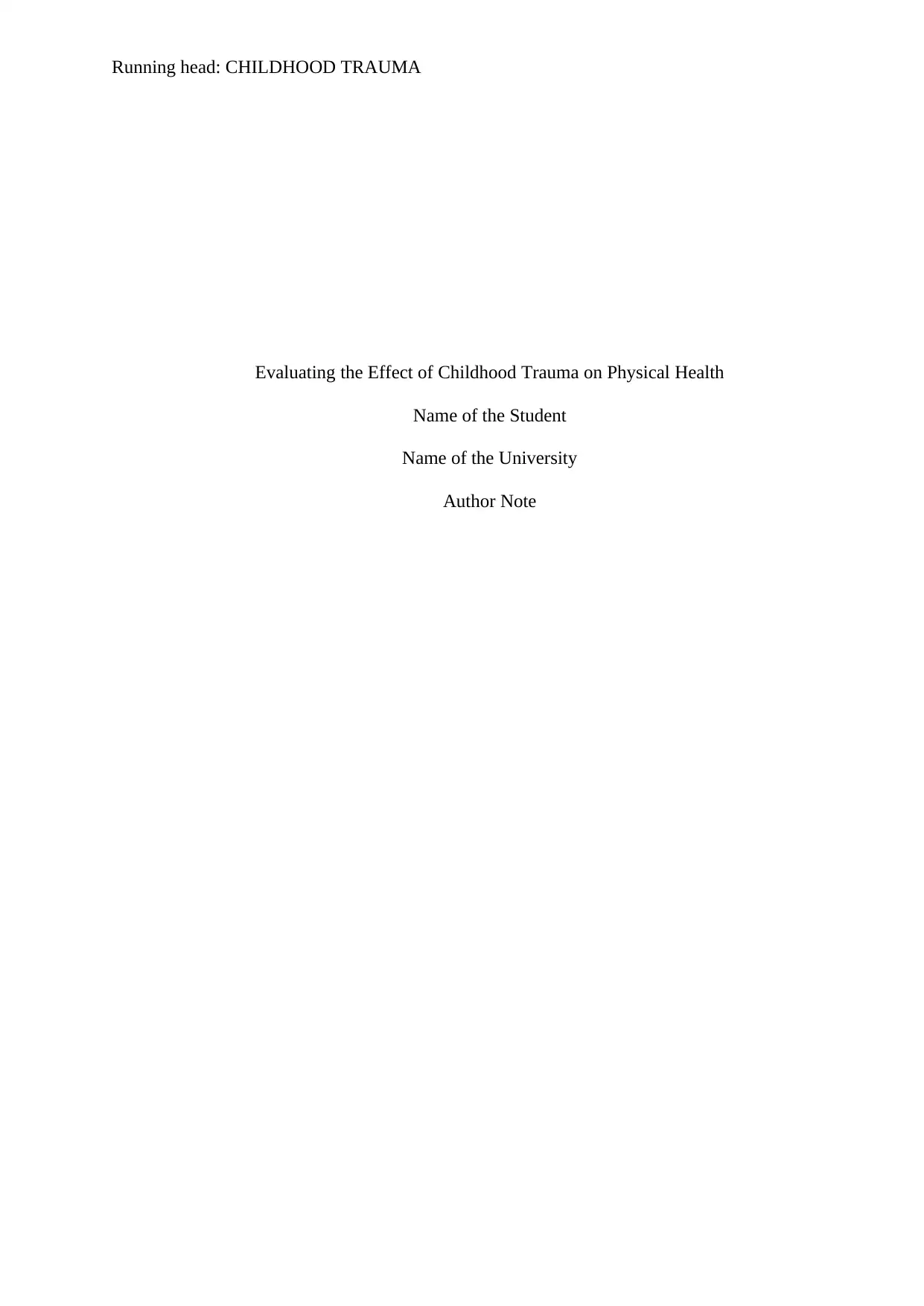
Running head: CHILDHOOD TRAUMA
Evaluating the Effect of Childhood Trauma on Physical Health
Name of the Student
Name of the University
Author Note
Evaluating the Effect of Childhood Trauma on Physical Health
Name of the Student
Name of the University
Author Note
Paraphrase This Document
Need a fresh take? Get an instant paraphrase of this document with our AI Paraphraser
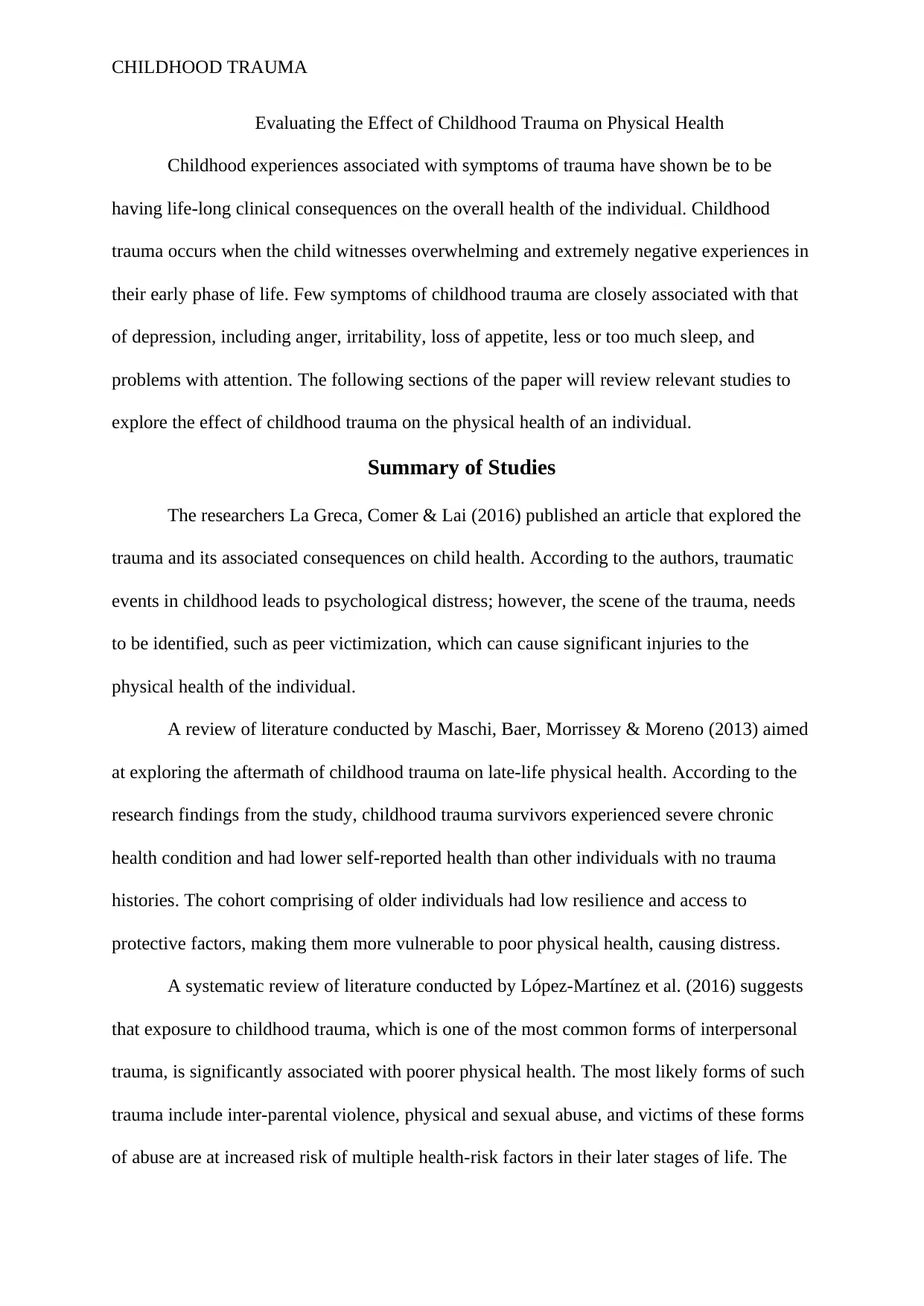
CHILDHOOD TRAUMA
Evaluating the Effect of Childhood Trauma on Physical Health
Childhood experiences associated with symptoms of trauma have shown be to be
having life-long clinical consequences on the overall health of the individual. Childhood
trauma occurs when the child witnesses overwhelming and extremely negative experiences in
their early phase of life. Few symptoms of childhood trauma are closely associated with that
of depression, including anger, irritability, loss of appetite, less or too much sleep, and
problems with attention. The following sections of the paper will review relevant studies to
explore the effect of childhood trauma on the physical health of an individual.
Summary of Studies
The researchers La Greca, Comer & Lai (2016) published an article that explored the
trauma and its associated consequences on child health. According to the authors, traumatic
events in childhood leads to psychological distress; however, the scene of the trauma, needs
to be identified, such as peer victimization, which can cause significant injuries to the
physical health of the individual.
A review of literature conducted by Maschi, Baer, Morrissey & Moreno (2013) aimed
at exploring the aftermath of childhood trauma on late-life physical health. According to the
research findings from the study, childhood trauma survivors experienced severe chronic
health condition and had lower self-reported health than other individuals with no trauma
histories. The cohort comprising of older individuals had low resilience and access to
protective factors, making them more vulnerable to poor physical health, causing distress.
A systematic review of literature conducted by López-Martínez et al. (2016) suggests
that exposure to childhood trauma, which is one of the most common forms of interpersonal
trauma, is significantly associated with poorer physical health. The most likely forms of such
trauma include inter-parental violence, physical and sexual abuse, and victims of these forms
of abuse are at increased risk of multiple health-risk factors in their later stages of life. The
Evaluating the Effect of Childhood Trauma on Physical Health
Childhood experiences associated with symptoms of trauma have shown be to be
having life-long clinical consequences on the overall health of the individual. Childhood
trauma occurs when the child witnesses overwhelming and extremely negative experiences in
their early phase of life. Few symptoms of childhood trauma are closely associated with that
of depression, including anger, irritability, loss of appetite, less or too much sleep, and
problems with attention. The following sections of the paper will review relevant studies to
explore the effect of childhood trauma on the physical health of an individual.
Summary of Studies
The researchers La Greca, Comer & Lai (2016) published an article that explored the
trauma and its associated consequences on child health. According to the authors, traumatic
events in childhood leads to psychological distress; however, the scene of the trauma, needs
to be identified, such as peer victimization, which can cause significant injuries to the
physical health of the individual.
A review of literature conducted by Maschi, Baer, Morrissey & Moreno (2013) aimed
at exploring the aftermath of childhood trauma on late-life physical health. According to the
research findings from the study, childhood trauma survivors experienced severe chronic
health condition and had lower self-reported health than other individuals with no trauma
histories. The cohort comprising of older individuals had low resilience and access to
protective factors, making them more vulnerable to poor physical health, causing distress.
A systematic review of literature conducted by López-Martínez et al. (2016) suggests
that exposure to childhood trauma, which is one of the most common forms of interpersonal
trauma, is significantly associated with poorer physical health. The most likely forms of such
trauma include inter-parental violence, physical and sexual abuse, and victims of these forms
of abuse are at increased risk of multiple health-risk factors in their later stages of life. The
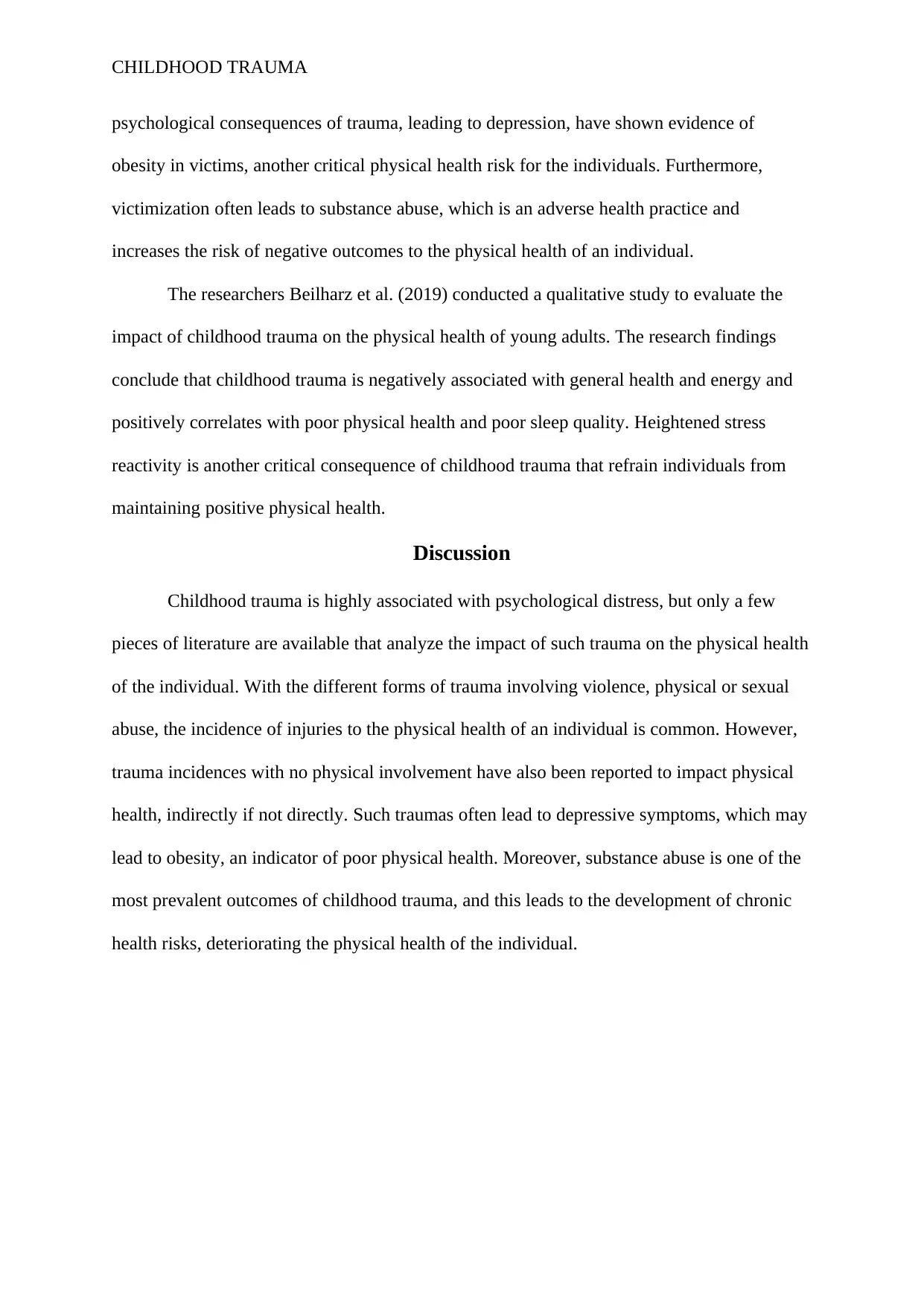
CHILDHOOD TRAUMA
psychological consequences of trauma, leading to depression, have shown evidence of
obesity in victims, another critical physical health risk for the individuals. Furthermore,
victimization often leads to substance abuse, which is an adverse health practice and
increases the risk of negative outcomes to the physical health of an individual.
The researchers Beilharz et al. (2019) conducted a qualitative study to evaluate the
impact of childhood trauma on the physical health of young adults. The research findings
conclude that childhood trauma is negatively associated with general health and energy and
positively correlates with poor physical health and poor sleep quality. Heightened stress
reactivity is another critical consequence of childhood trauma that refrain individuals from
maintaining positive physical health.
Discussion
Childhood trauma is highly associated with psychological distress, but only a few
pieces of literature are available that analyze the impact of such trauma on the physical health
of the individual. With the different forms of trauma involving violence, physical or sexual
abuse, the incidence of injuries to the physical health of an individual is common. However,
trauma incidences with no physical involvement have also been reported to impact physical
health, indirectly if not directly. Such traumas often lead to depressive symptoms, which may
lead to obesity, an indicator of poor physical health. Moreover, substance abuse is one of the
most prevalent outcomes of childhood trauma, and this leads to the development of chronic
health risks, deteriorating the physical health of the individual.
psychological consequences of trauma, leading to depression, have shown evidence of
obesity in victims, another critical physical health risk for the individuals. Furthermore,
victimization often leads to substance abuse, which is an adverse health practice and
increases the risk of negative outcomes to the physical health of an individual.
The researchers Beilharz et al. (2019) conducted a qualitative study to evaluate the
impact of childhood trauma on the physical health of young adults. The research findings
conclude that childhood trauma is negatively associated with general health and energy and
positively correlates with poor physical health and poor sleep quality. Heightened stress
reactivity is another critical consequence of childhood trauma that refrain individuals from
maintaining positive physical health.
Discussion
Childhood trauma is highly associated with psychological distress, but only a few
pieces of literature are available that analyze the impact of such trauma on the physical health
of the individual. With the different forms of trauma involving violence, physical or sexual
abuse, the incidence of injuries to the physical health of an individual is common. However,
trauma incidences with no physical involvement have also been reported to impact physical
health, indirectly if not directly. Such traumas often lead to depressive symptoms, which may
lead to obesity, an indicator of poor physical health. Moreover, substance abuse is one of the
most prevalent outcomes of childhood trauma, and this leads to the development of chronic
health risks, deteriorating the physical health of the individual.
⊘ This is a preview!⊘
Do you want full access?
Subscribe today to unlock all pages.

Trusted by 1+ million students worldwide
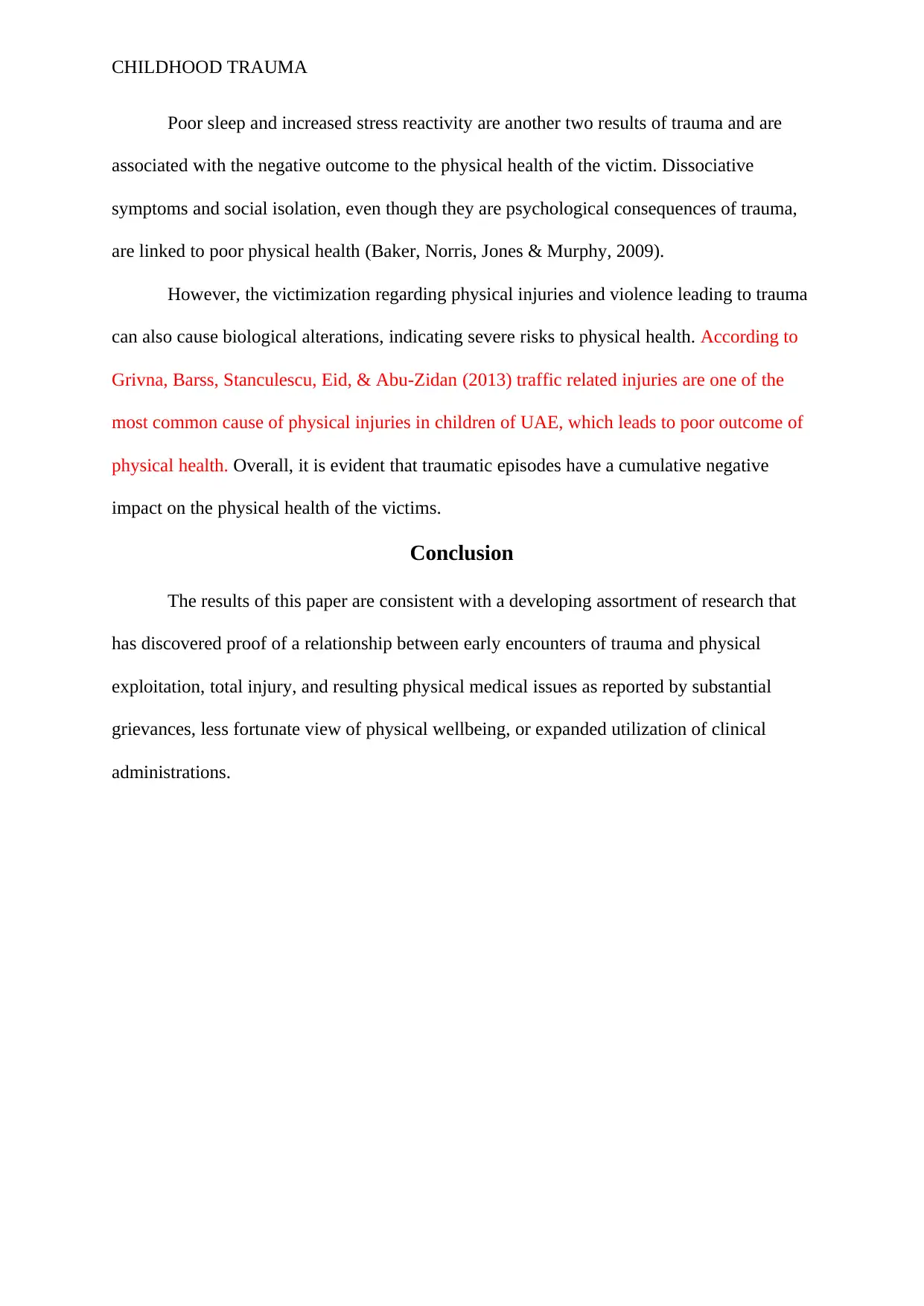
CHILDHOOD TRAUMA
Poor sleep and increased stress reactivity are another two results of trauma and are
associated with the negative outcome to the physical health of the victim. Dissociative
symptoms and social isolation, even though they are psychological consequences of trauma,
are linked to poor physical health (Baker, Norris, Jones & Murphy, 2009).
However, the victimization regarding physical injuries and violence leading to trauma
can also cause biological alterations, indicating severe risks to physical health. According to
Grivna, Barss, Stanculescu, Eid, & Abu-Zidan (2013) traffic related injuries are one of the
most common cause of physical injuries in children of UAE, which leads to poor outcome of
physical health. Overall, it is evident that traumatic episodes have a cumulative negative
impact on the physical health of the victims.
Conclusion
The results of this paper are consistent with a developing assortment of research that
has discovered proof of a relationship between early encounters of trauma and physical
exploitation, total injury, and resulting physical medical issues as reported by substantial
grievances, less fortunate view of physical wellbeing, or expanded utilization of clinical
administrations.
Poor sleep and increased stress reactivity are another two results of trauma and are
associated with the negative outcome to the physical health of the victim. Dissociative
symptoms and social isolation, even though they are psychological consequences of trauma,
are linked to poor physical health (Baker, Norris, Jones & Murphy, 2009).
However, the victimization regarding physical injuries and violence leading to trauma
can also cause biological alterations, indicating severe risks to physical health. According to
Grivna, Barss, Stanculescu, Eid, & Abu-Zidan (2013) traffic related injuries are one of the
most common cause of physical injuries in children of UAE, which leads to poor outcome of
physical health. Overall, it is evident that traumatic episodes have a cumulative negative
impact on the physical health of the victims.
Conclusion
The results of this paper are consistent with a developing assortment of research that
has discovered proof of a relationship between early encounters of trauma and physical
exploitation, total injury, and resulting physical medical issues as reported by substantial
grievances, less fortunate view of physical wellbeing, or expanded utilization of clinical
administrations.
Paraphrase This Document
Need a fresh take? Get an instant paraphrase of this document with our AI Paraphraser
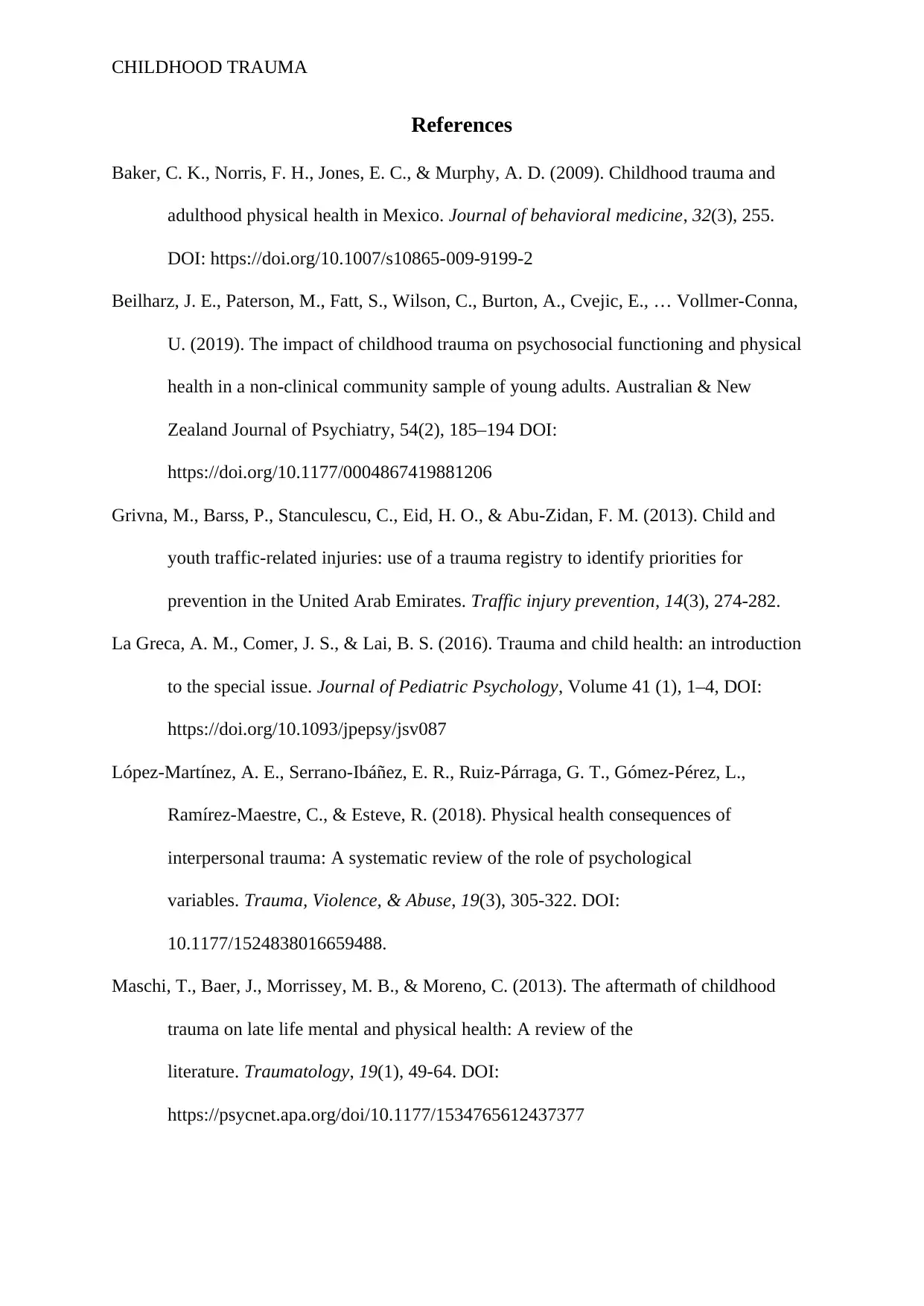
CHILDHOOD TRAUMA
References
Baker, C. K., Norris, F. H., Jones, E. C., & Murphy, A. D. (2009). Childhood trauma and
adulthood physical health in Mexico. Journal of behavioral medicine, 32(3), 255.
DOI: https://doi.org/10.1007/s10865-009-9199-2
Beilharz, J. E., Paterson, M., Fatt, S., Wilson, C., Burton, A., Cvejic, E., … Vollmer-Conna,
U. (2019). The impact of childhood trauma on psychosocial functioning and physical
health in a non-clinical community sample of young adults. Australian & New
Zealand Journal of Psychiatry, 54(2), 185–194 DOI:
https://doi.org/10.1177/0004867419881206
Grivna, M., Barss, P., Stanculescu, C., Eid, H. O., & Abu-Zidan, F. M. (2013). Child and
youth traffic-related injuries: use of a trauma registry to identify priorities for
prevention in the United Arab Emirates. Traffic injury prevention, 14(3), 274-282.
La Greca, A. M., Comer, J. S., & Lai, B. S. (2016). Trauma and child health: an introduction
to the special issue. Journal of Pediatric Psychology, Volume 41 (1), 1–4, DOI:
https://doi.org/10.1093/jpepsy/jsv087
López-Martínez, A. E., Serrano-Ibáñez, E. R., Ruiz-Párraga, G. T., Gómez-Pérez, L.,
Ramírez-Maestre, C., & Esteve, R. (2018). Physical health consequences of
interpersonal trauma: A systematic review of the role of psychological
variables. Trauma, Violence, & Abuse, 19(3), 305-322. DOI:
10.1177/1524838016659488.
Maschi, T., Baer, J., Morrissey, M. B., & Moreno, C. (2013). The aftermath of childhood
trauma on late life mental and physical health: A review of the
literature. Traumatology, 19(1), 49-64. DOI:
https://psycnet.apa.org/doi/10.1177/1534765612437377
References
Baker, C. K., Norris, F. H., Jones, E. C., & Murphy, A. D. (2009). Childhood trauma and
adulthood physical health in Mexico. Journal of behavioral medicine, 32(3), 255.
DOI: https://doi.org/10.1007/s10865-009-9199-2
Beilharz, J. E., Paterson, M., Fatt, S., Wilson, C., Burton, A., Cvejic, E., … Vollmer-Conna,
U. (2019). The impact of childhood trauma on psychosocial functioning and physical
health in a non-clinical community sample of young adults. Australian & New
Zealand Journal of Psychiatry, 54(2), 185–194 DOI:
https://doi.org/10.1177/0004867419881206
Grivna, M., Barss, P., Stanculescu, C., Eid, H. O., & Abu-Zidan, F. M. (2013). Child and
youth traffic-related injuries: use of a trauma registry to identify priorities for
prevention in the United Arab Emirates. Traffic injury prevention, 14(3), 274-282.
La Greca, A. M., Comer, J. S., & Lai, B. S. (2016). Trauma and child health: an introduction
to the special issue. Journal of Pediatric Psychology, Volume 41 (1), 1–4, DOI:
https://doi.org/10.1093/jpepsy/jsv087
López-Martínez, A. E., Serrano-Ibáñez, E. R., Ruiz-Párraga, G. T., Gómez-Pérez, L.,
Ramírez-Maestre, C., & Esteve, R. (2018). Physical health consequences of
interpersonal trauma: A systematic review of the role of psychological
variables. Trauma, Violence, & Abuse, 19(3), 305-322. DOI:
10.1177/1524838016659488.
Maschi, T., Baer, J., Morrissey, M. B., & Moreno, C. (2013). The aftermath of childhood
trauma on late life mental and physical health: A review of the
literature. Traumatology, 19(1), 49-64. DOI:
https://psycnet.apa.org/doi/10.1177/1534765612437377
1 out of 5
Related Documents
Your All-in-One AI-Powered Toolkit for Academic Success.
+13062052269
info@desklib.com
Available 24*7 on WhatsApp / Email
![[object Object]](/_next/static/media/star-bottom.7253800d.svg)
Unlock your academic potential
Copyright © 2020–2025 A2Z Services. All Rights Reserved. Developed and managed by ZUCOL.




